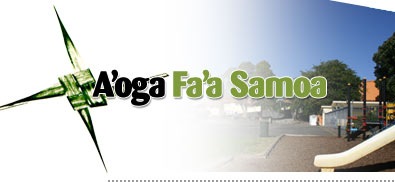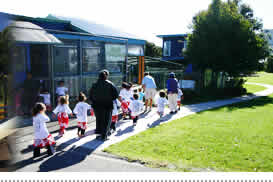 |
 |
|||||||
| Aoga Fa'aSamoa Resources | ||||||||
 |
|||||
CONTENTS
What is a Centre of Innovation? “Centres of Innovation” (COI) is a Ministry of Education initiative falling out of their 10 year strategic plan for Early Childhood Education (ECE) – Pathways to the Future. Early Childhood Education Centres of Innovation (COIs) were announced in Pathways to the Future, Nga Huarahi Arataki (2002). Teachers and educators in six COIs will research what gives their centre a reputation for effectiveness, and will open their doors to show others their innovations and findings. Centres of Innovation will take on the following responsibilities for three years:
Press Release, Ministry of Education, 2003. " Investing in quality early childhood education is crucial to children's learning and their opportunities in later life," " The good teaching and learning practices these centres are currently using will be further developed in collaboration with researchers and that information will then be available to other services." " This investment is part of the Government's commitment to increasing participation, improving quality and promoting collaborative relationships in early childhood education. This is particularly important for Maori and Pacific children who currently participate less than others." Education Minister Trevor Mallard. Visit this link at the Ministry of Education website for detailed information about COI.
Six ECE Centres chosen to be Centres of Innovation. Special characteristics were important in the selection of the six Centres of Innovation. They include competent practice in teaching and learning in: Kaupapa Maori services, Pasifika immersion and bilingual services, Services that integrate IT and ICT into the curriculum, and ‘Community of learning’ approaches evident in the collaborative relationships with parents and whanau, and with other programmes, agencies and/or schools also mattered. The Six Centres of Innovation are:
For more information about COI visit www.minedu.govt.nz
Aoga Fa’a Samoa is a “Centre of Innovation” A'oga Fa'asamoa is a Samoan immersion education and care centre located in Ponsonby, Auckland. Infants, toddlers and young children attend for up to nine hours daily, up to five days per week, learning in the Samoan language. In May 2003 the A'oga Fa’a Samoa was selected by the Ministry of Education to be one of six Centres of Innovation nationwide to undertake a three-year research and development project. Special characteristics of the A’oga Fa’a Samoa are its’ Samoan immersion programme, and its “community of learners” collaborative approach.
Innovative Teaching and Learning at A'oga Fa'a Samoa. A'oga Fa'a Samoa uses a rich array of approaches to promote Samoan language and culture and the children's cultural identity. It has close links with the school communities on site, especially the bilingual Samoan class in the school for transition of children and to help maintain confident and competent bilingual speakers. Small groups of children stay with the same teacher from point of entry through different groups and spaces in the centre and into school. The effects on children's learning, including learning Samoan language and culture, of joint educator-child transitions will be studied.
This project is designed to examine the relationship between learning and language continuity, as children and educators at the centre make transitions from the point of entry through to beginning school. A related intention is to document aspects of the identity, strength and the confidence of the children.
Key people involved with COI project.
The COI research associates for the Aoga Fa’a Samoa are.
|
Rationale for a Focus (Advisory) Group. The COI project draws on the action research approaches used previously in New Zealand studies (Carr, May, & Podmore, 2000) to implement an action research spiral approach. This includes observing, reflecting, planning, and acting (derived from Kemmis and McTaggart, 1988). Data collection methods include focus group interviews and discussions, observations, teacher diaries, and survey/self-report techniques. Focus Group Interviews. The focus group will be an advisory team who will lead the COI project, as well as an focus group. The focus group includes a facilitator, 2 staff members, 2 researchers, 1 representative from centre management, 2 parents, the centre manager, a centre support person. The focus group ensures full involvement of the centre. Focus Group Questions.
What helps learning and language continuity as children make transitions within and from the Aoga faa-Samoa? How can the key approaches that help learning and language continuity be complemented in practice?
The research is designed to address the above research questions within the context of the Aoga faa-Samoa and its community as well the benefit to the wider community. The sampling design includes children at two transition points as well staff at the centre. The transition points are:
COI Information Dissemination. To facilitate effective dissemination of COI information and activities, the Aoga Fa’a Samoa has: Developed a visitor’s policy. With an increased influx of visitors, we must consider very carefully how we can provide for visitors and at the same time ensure that. The children’s programme is not compromised or disrupted.
Begun to construct a web site for dissemination of up-to-date information via the internet. We are hoping to launch this website by the end of May 2004. The proposed website URL is www.aogafaasamoa.school.nz COI Progress
to Date. Since being selected as a Centre of Innovation Aoga Fa’a Samoa has successfully:
These initial stages have been very encouraging and exciting and we are looking forward to completing and reporting on the first spiral of our COI research. If you have any questions or concerns, please do not hesitate to discuss them with Jan Taouma. Jan’s contact details are:
COI Published Papers, Workshops, Conferences & Presentations. 2006 “O le tama ma lana a’oga, O le tama ma lona fa’asinomaga” Final Research Report from the A’oga Fa’a Samoa. A Report
for the Ministry of Education
2004 A research paper prepared for the A’oga Fa’a Samoa, Auckland, and the University of Victoria at Wellington, New Zealand. This paper is about adult perceptions of what helps children through transition phases within a Samoa immersion ECE setting, and from that setting into primary school. In short, this is about times of change in ECE and what helps make them happen in ways beneficial to a child’s holistic development. Download this document as a PDF
2003 Download this document as a PDF
2003 Download this document as a PDF
|
||||
Calendar
of Events • About Us • Best
Practice • Parents Section |
|||||